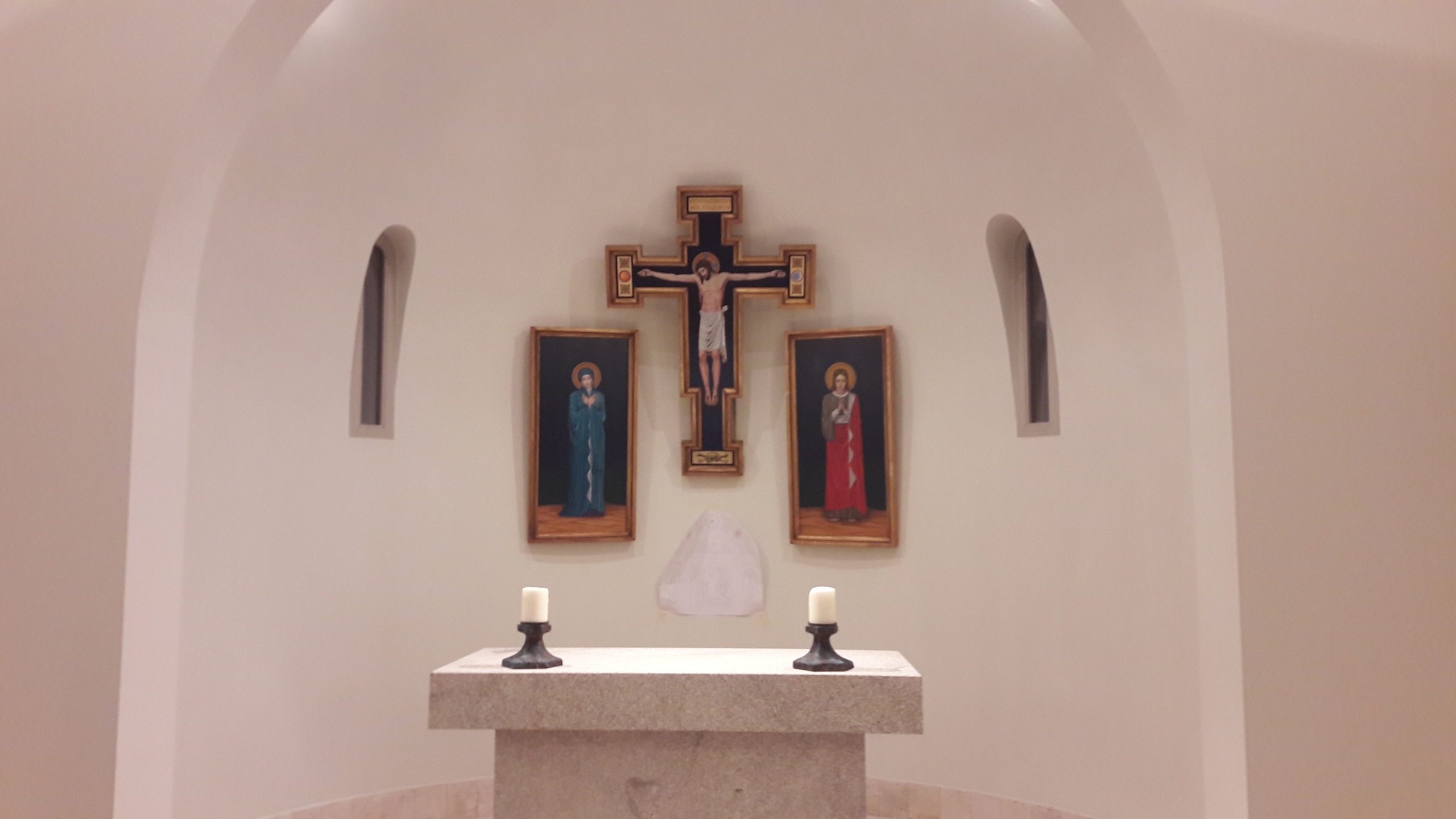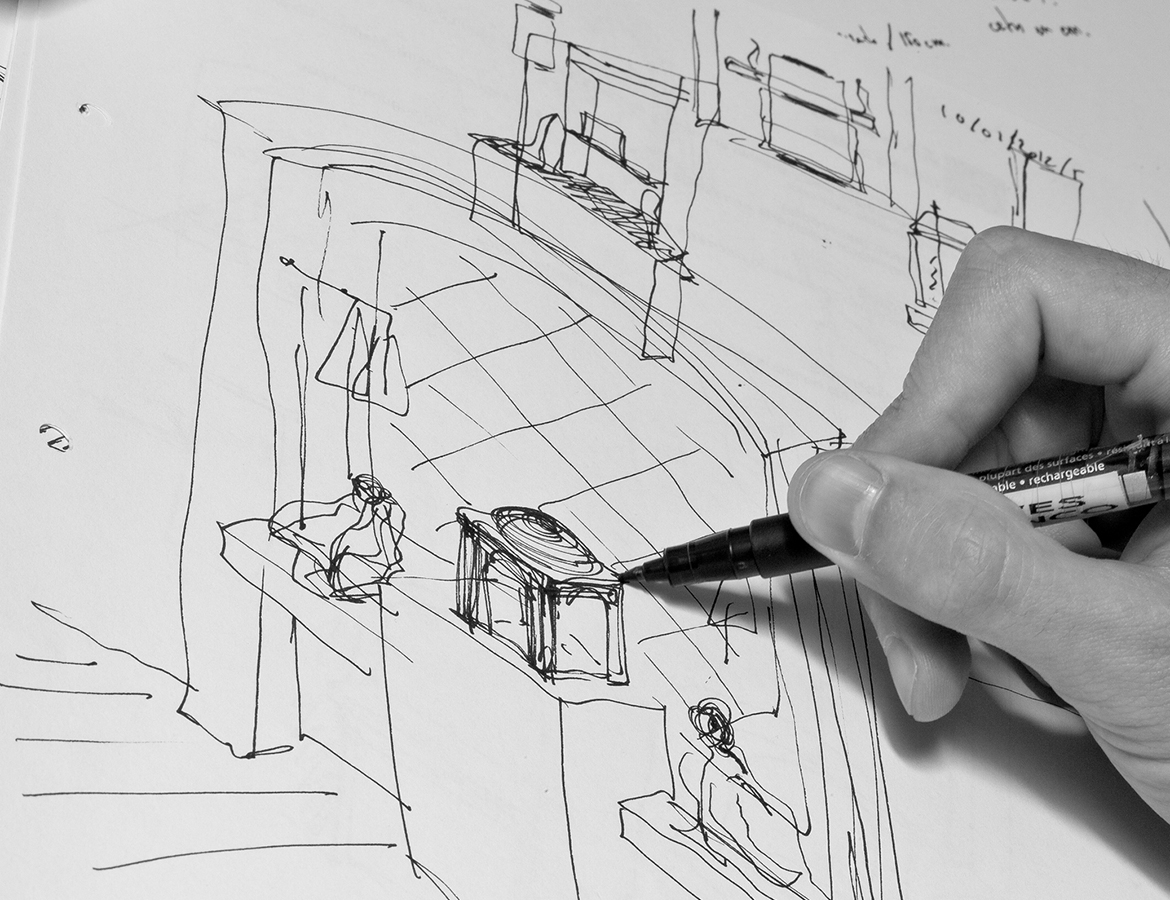A PRIVATE CHAPEL LOCATED IN AN OLIVE GROVE
A team from Granda travels to Portugal to visit a small chapel, located on a rustic farm surrounded by a vast expanse of olive groves and fruit trees.. The land is fertile and the arrival of spring is beginning to be felt. The farm has several buildings for different uses and, moreover, in a secluded location, a small Romanesque chapel where silence reigns.
After the visit, we began the task, with the purpose of to give the chapel a liturgical character and to find the necessary iconographic elements to enrich it.
THE CRUCIFIXION, OIL ON PANEL, FOR THE PRESBYTERY
After the work of the planners and designers, it was concluded that the workshop would be used to produce a composition of three oil-painted panels that will form, as a whole, the scene of the Crucifixion.
The style of the paintings is in the Romanesque tradition: The crucifix presides over the space and two images of the Virgin Mary and St. John accompany it on both sides. The Calvary complex, highlighted on the white of the presbytery wall, is unified by the application of color, the only one in the chapel, thus generating a colorful and warm focal point.

The ensemble is inspired by medieval crucifixes, such as the well-known Christ of San Damiano (1) and this other similar and contemporary crucifix by the artist Alberto Sozio (2).
THE PRIVATE CHAPEL, WHAT IS IT AND WHAT ARE ITS PECULIARITIES?
Canon law makes a distinction between the various places of worship: Thus, a church is "a sacred building destined for divine worship, which the faithful have the right to enter for the celebration of worship, especially in public" (canon 1214). oratory is that "place destined for divine worship with the license of the Ordinary, for the benefit of a community or group of the faithful, with the consent of the competent Superior" (canon 1223) and a private chapel is a place "destined for divine worship, licensed by the local Ordinary for the benefit of one or more individuals" (canon 1226).
Private chapels are usually small in size and more humble in construction, but they are are, like oratories and churches, sacred buildings dedicated to divine worship, "beautiful and worthy signs and symbols of heavenly realities". (Instruction, number 288).
For this reason, the architecture of these places of worship must observe a series of canonical and liturgical provisions. The noblest place in the house is usually chosen for it, away from the bustle of the house, so that it helps in the recollection for prayer and the celebration of the Holy Mass. General Institution of the Roman Missal and to the canons of universal law.

ESSENTIAL ELEMENTS OF A PRIVATE CHAPEL
-The Altar: It is the element where the sacrifice of the Cross is made present under the sacramental signs. The liturgy does not require that the altar be fixed, although if it is attached to the floor it will be "the clearest and most permanent sign of Christ Jesus, the living Stone". If it is fixed, it will be dedicated; if it is mobile, it will only be blessed, keeping a copy in the archives and sending another to the Archbishopric (General Institution of the Roman Missal, no. 300). Its size should be neither too small nor too large, and its format should make it easy for the faithful to see on it the table of the Lord, to whose participation the people of God are summoned at Mass. Its material should be stone or some other material "worthy, solid and expertly worked" (General Institution of the Roman Missal, no. 301).
-The altar must have a cross and some candlesticks. On it will be placed everything necessary for the Eucharistic sacrifice: a worthy white tablecloth, the chalice covered with a veil (pallia), the paten, the corporal, the purificator, the cruets, a small pitcher with water, a ewer and small towel and the communion plate.
-The Presbytery: is the place where the altar is located, the Word of God is proclaimed, and the priest, the deacon and the other ministers exercise their function" (...) "it should be suitably distinguished from the nave of the church, either because it is on a higher level or because of its peculiar structure and ornament" (General Institution of the Roman Missal, no. 295).
-The Ship: It is the space occupied by the faithful during the celebrations. It should contribute to piety and participation, allowing the postures commanded in the liturgy, especially kneeling for adoration. Lighting and ventilation are also elements to be taken into account so as not to hinder participation in worship.
-The chapel may have necessary, but not indispensable, elements, such as a sagrarioif permission has been obtained to reserve the sacramental species, a ambo and a site.
